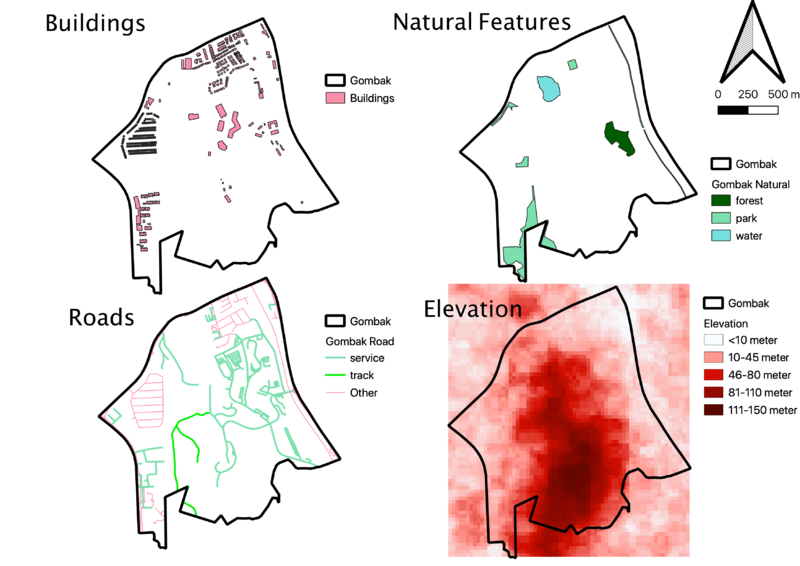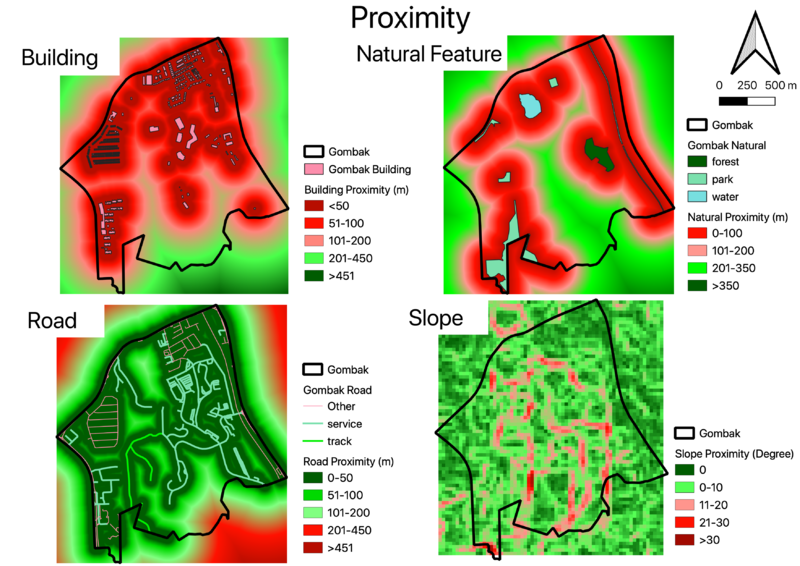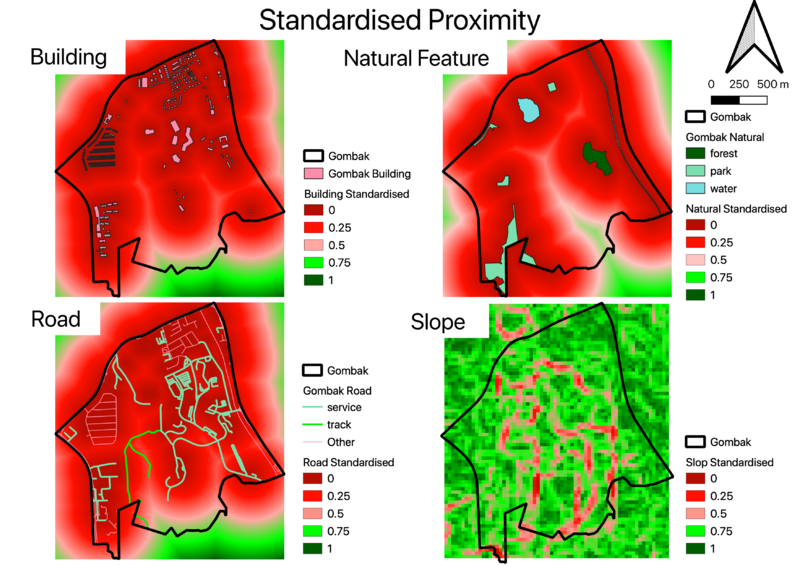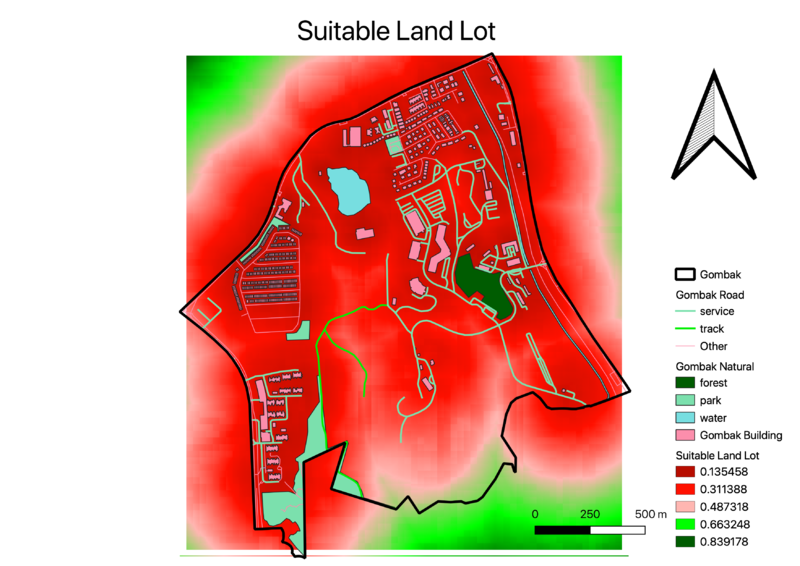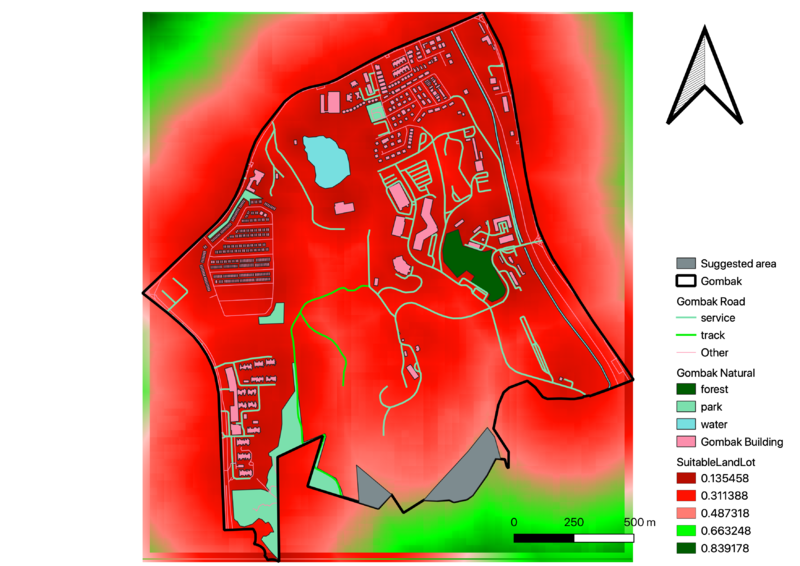SMT201 AY2019-20G1 EX2 Riana
Contents
Objective
The motive of this project is to find a suitable location for building a National Communicable Disease Quarantine Centre. The selected site must be located in Gombak Planning Subzone. Criteria:
- A contiguous area of 10,000 m2
- Factors:
- Economic Factor: avoid steep slope
- Accessibility Factor: close to existing local roads, namely: service roads and tracks
- Health Risk Factor: The selected site should be away from population
- Natural Conservation Factor: The selected site should be away from forested land, park and water.
Overview of Gombak Subzone
Roads, Buildings and Natural (SHP) from https://www.bbbike.org/Singapore/.
ASTER Global Digital Elevation Model (GDEM) dataset (TIFF) jointly prepared by NASA and METI, Japan from https://search.earthdata.nasa.gov/
Buildings (Health Risk Factor)
Buildings in Gombak subzone are mostly located around the boundary with some located in the central. It is densely populated in the northern part of Gombak subzone since there are quite a number of buildings situated. Therefore, southern part of Gombak subzone seems to be more appropriate to build the quarantine centre in order to satisfy the health risk factor.
Natural Features (Natural Conservation Factor)
Natural features in Gombak subzone seems to be spread across the whole area. In the east side there are forest and water bodies. North side have situated water body and 2 parks. Following by 2 parks located in western to south-west of Gombak Subzone. Looking at the spread, central and south-east of Gombak Subzone will be the appropriate place to build the quarantine centre.
Roads (Accessibility Factor)
Road’s spread in Gombak subzone are quite comprehensive of the area except on the southern part which are not covered by any part of roads. Eastern part of Gombak subzone is the most accessible as they has the most number of roads. Therefore, looking at the accessibility factor, building the quarantine centre in eastern part of Gombak subzone will be the most accessible.
Elevation (Economic Factor)
There are high elevation covered from central to southern of Gombak subzone. While around the boundary, there are less elevation especially on the northern part. Thus, looking at the economic factor, it is more appropriate to build the quarantine central at the northern part of Gombak subzone.
Proximity of the Four Factors
Roads, Buildings and Natural (SHP) from https://www.bbbike.org/Singapore/.
ASTER Global Digital Elevation Model (GDEM) dataset (TIFF) jointly prepared by NASA and METI, Japan from https://search.earthdata.nasa.gov/
Building Proximity (Health Risk Factor)
The green color depicts suitable area while red color otherwise. The furthest distance from the buildings is 816.36 meters. The southern part and some part of the central are the suitable lot for building a quarantine centre.
Natural Features Proximity (Natural Conservation Factor)
The green color depicts suitable area while red color otherwise. The furthest distance from the natural conservation is 847.27 meters. The southern, central, and some part of west are the suitable lot for building a quarantine centre.
Road Proximity (Accessibility Factor)
The green color depicts accessible area while red color otherwise. The furthest distance from the road is 717.03 meter. I have chosen below 200 meter as a cut off for accessible area since walk time for 200 meter should take around 5 minutes. Most area of Gombak are quite accessible by roads except the southern part as said above. Therefore, looking at the road proximity, all area is suitable to build the quarantine centre except southern area.
Slope Proximity (Economy Factor)
The green color depicts flatter area while red color otherwise. The steepest area has a degree of 36.43. Despite high coverage of elevated area, it seems that Gombak subzone as a rather flatten steep. It is suitable to build the quarantine centre on the green area of the map.
Criterion Scores for the Four Factors
Roads, Buildings and Natural (SHP) from https://www.bbbike.org/Singapore/.
ASTER Global Digital Elevation Model (GDEM) dataset (TIFF) jointly prepared by NASA and METI, Japan from https://search.earthdata.nasa.gov/
I had standardised the proximity using Min-Max method in order to find the most suitable area for the quarantine centre.
Criterion Score for Building (Health Risk Factor)
Formula : “(Proximity to Building – Max(Proximity to Building))/(Max(Proximity to Building)-Min(Proximity to Building))” The green color depict the suitable land lot while red color otherwise. Differs from the proximity analysis, the standardised proximity seems to eliminate central area out from the suitable lot.
Criterion Score for Natural Features (Natural Conservation Factor)
Formula : “(Proximity to Natural Features – Max(Proximity to Natural Features))/(Max(Proximity to Natural Features)-Min(Proximity to Natural Features))” The green color depict the suitable land lot while red color otherwise. Differs from the proximity analysis, the standardised proximity seems to eliminate central and western area out from the suitable lot.
Criterion Score for Road (Accessibility Factor)
Formula : “1 - (Proximity to Road – Max(Proximity to Road))/(Max(Proximity to Road)-Min(Proximity to Road))” The green color depict the suitable land lot while red color otherwise. The result of the standardisation is similar to the proximity analysis.
Criterion Score for Slope (Economic Factor)
Formula : “1 - (Proximity to Slope – Max(Proximity to Slope))/(Max(Proximity to Slope)-Min(Proximity to Slope))” The green color depict the suitable land lot while red color otherwise. The result of the standardisation is similar to the proximity analysis.
Analytical Hierarchy Process (AHP) Input Matrix and Result Report
The matrix above shown the relative importance of each factors. after considering all the factors, I realise that the most important factor is the health risk factor as it is the reason why there is a need for a quarantine centre. The second will be natural conservation risk as it may be polluted by contagious disease and spread the disease around. Third will be the accessibility as ambulance will transport the emergency patient through the roads. However, roads are relatively easy to build. Therefore, it is rank third. The last will be economic factor as in the proximity analysis it shown that there are more flatten area.
The result from AHP is as follow:
Therefore, the formula for suitable land raster is as follow: ("SlopeNormalise@1”*0.051) + ("RoadNormalise@1”*0.121) + ("BuildingNormalise@1”*0.586) + ("NaturalNormalise@1"*0.242)
Suitable Land Lot
Roads, Buildings and Natural (SHP) from https://www.bbbike.org/Singapore/.
ASTER Global Digital Elevation Model (GDEM) dataset (TIFF) jointly prepared by NASA and METI, Japan from https://search.earthdata.nasa.gov/
The map above are the raster generated for the suitable land lot. Green area are the suitable area with red depicts otherwise. It is shown that the southern area are the suitable land lot.
Roads, Buildings and Natural (SHP) from https://www.bbbike.org/Singapore/.
ASTER Global Digital Elevation Model (GDEM) dataset (TIFF) jointly prepared by NASA and METI, Japan from https://search.earthdata.nasa.gov/
The map above include the suggested land lot. For smaller polygon, it has area of 13,867 m2 while the bigger area has coverage of 40,943 m2
